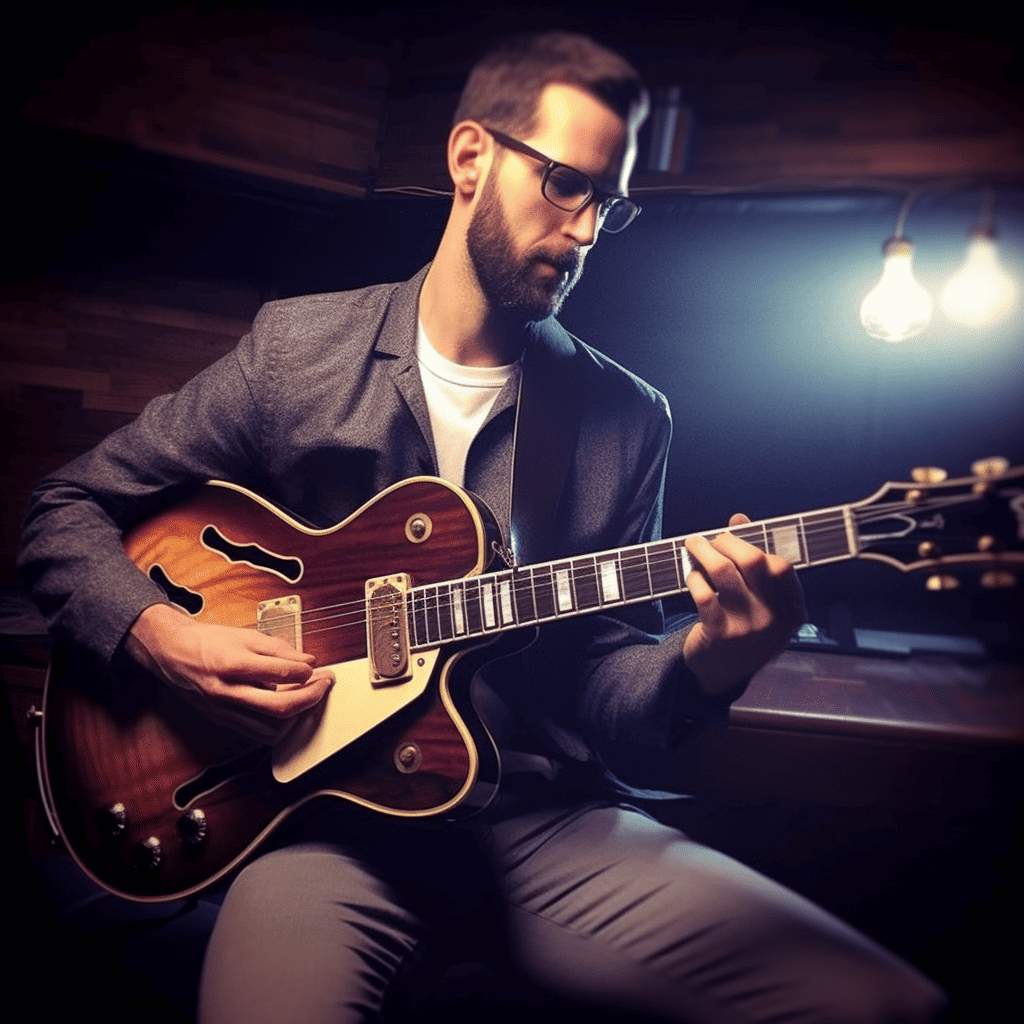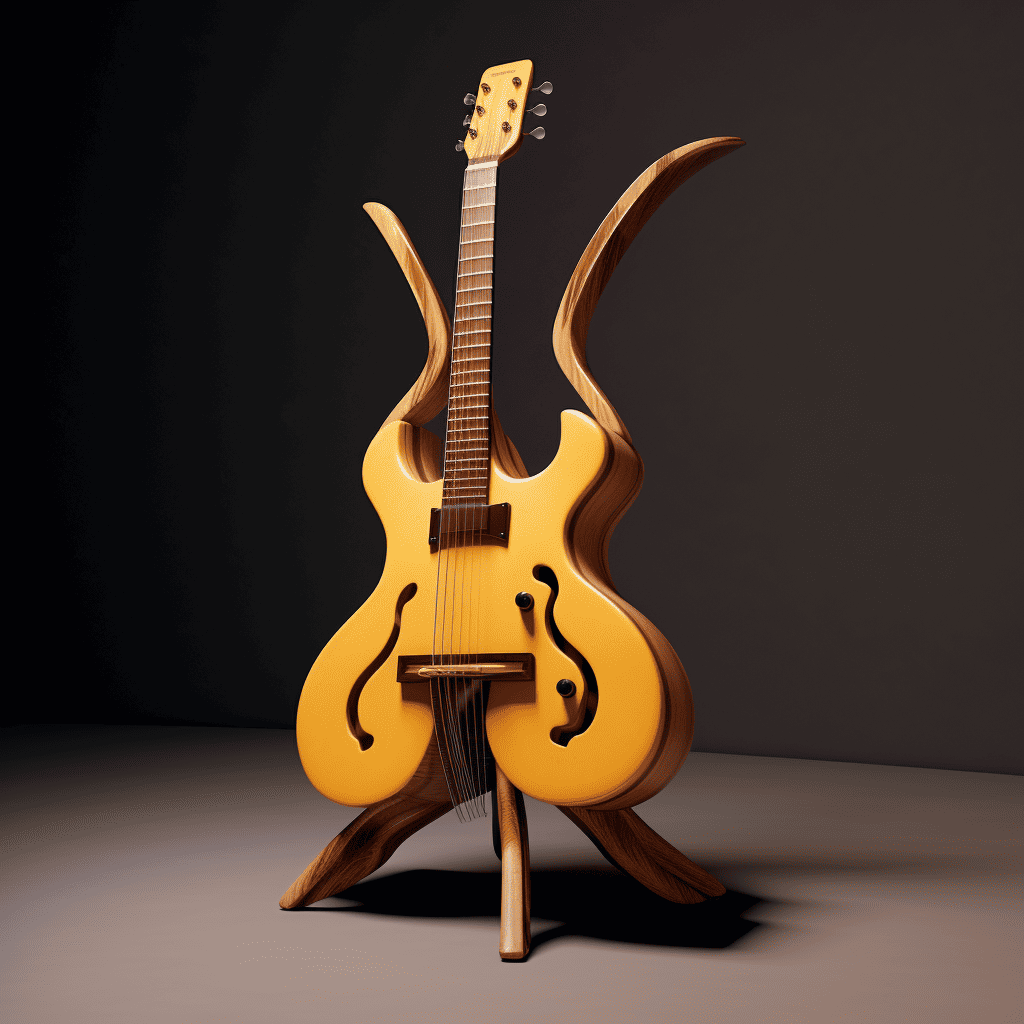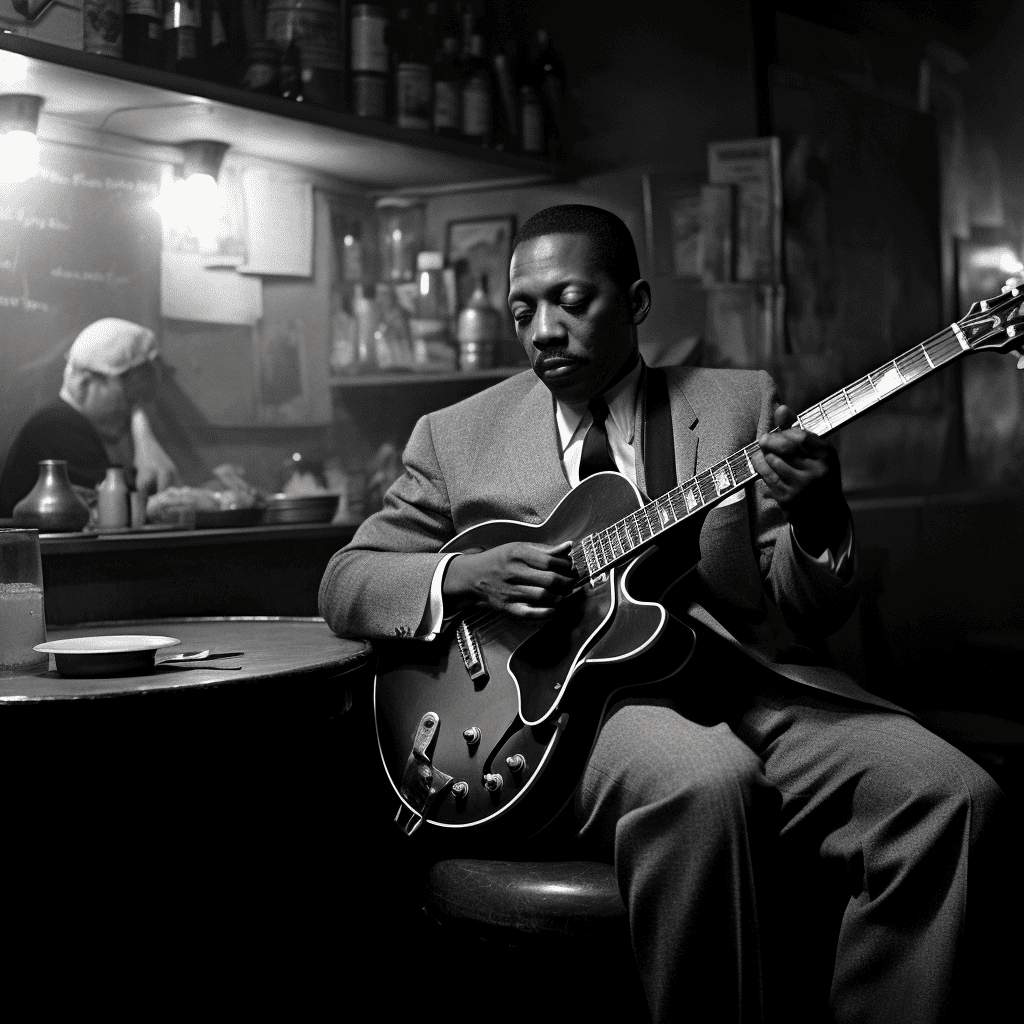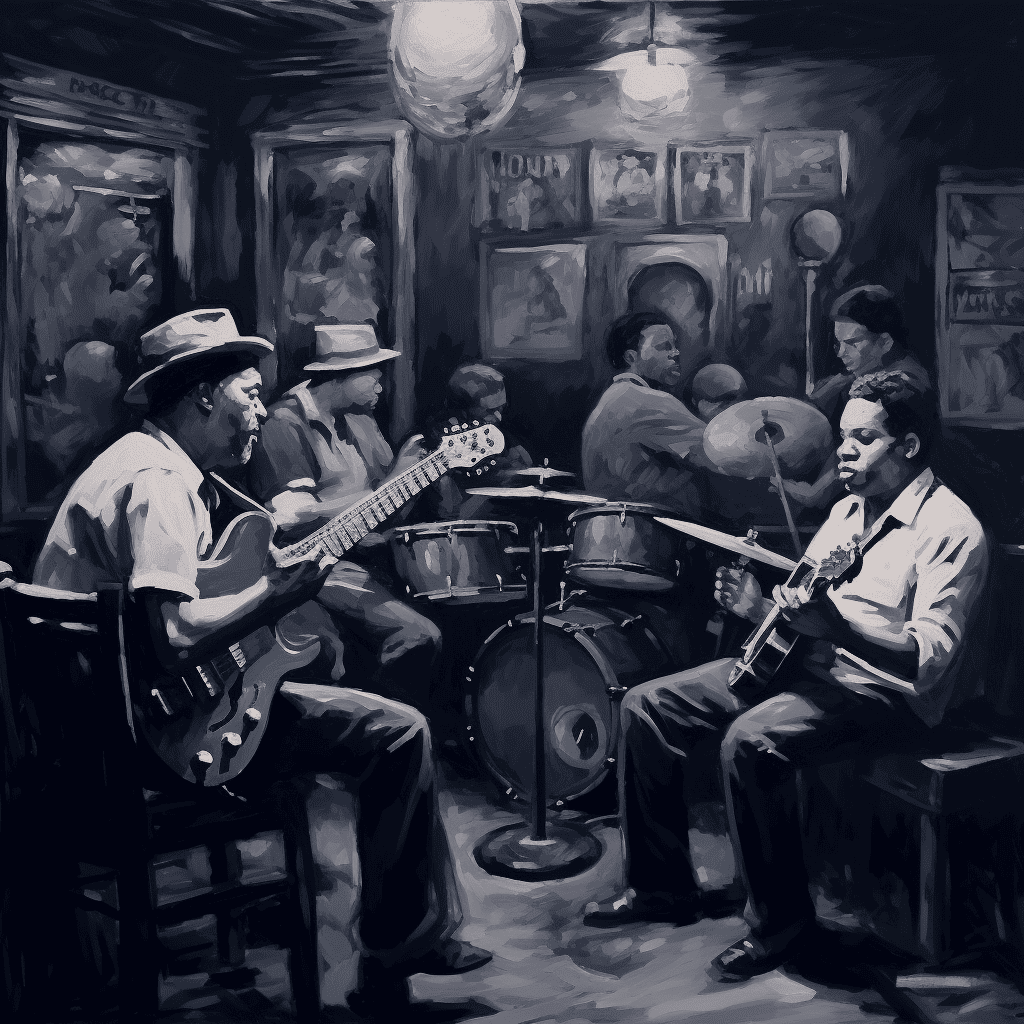If you’re like me, a fellow guitar enthusiast, the unique charm and allure of different types of guitars such as acoustic guitars, electric guitars, and even bass guitars can be incredibly enticing. You might have seen, heard, or even played an array of guitars – strumming on a classic dreadnought, feeling the smooth curves of a Les Paul, or getting lost in the twang of a Telecaster. However, there’s one distinctive type that might have caught your attention and ignited your curiosity – the archtop guitar. ‘What is an archtop guitar?’ you may wonder. Join me on this exciting exploration to unravel the mystery and allure of this unique instrument, the archtop, a true marvel among both acoustic and electric guitars.
A Walk Through History: The Birth of the Archtop
First, let’s hop into the time machine and take a quick detour into the annals of guitar history, where archtop guitars have a special place. Our destination? The late 19th century. The archtop guitar, with its uniquely curved top (or ‘arched’ top, hence the name), is a product of this vibrant period in music history. Orville Gibson, the founder of the now-iconic Gibson Guitar Corporation, is credited with the archtop guitar’s inception. With a background in violin making, Gibson implemented violin-like principles, akin to the construction of instruments in the violin family, into his guitar crafting, creating a novel instrument that merged the best of both worlds, the traditional flat-top guitars and violins.
Spotting the Archtop: Unique Physical Traits

Fast forward to the present, and you might be wondering, ‘How do I recognize an archtop guitar?’ Well, dear reader, the clue is in the name. The defining feature of an archtop, distinguishing it from standard acoustic guitars and flat-top guitars, is its curved, or ‘arched,’ top. Unlike the flat top of your conventional acoustic guitar or flat top guitar, the top of an archtop swoops upward, giving the instrument its characteristic shape. This unique design is not purely aesthetic, though; it imparts a distinctive arched top that influences the guitar’s sound, producing a distinct tone that’s made the archtop a beloved choice for many guitarists, including popular jazz guitarists.
The Archtop Sound: What Makes It Unique
This leads us to another crucial aspect: the sound. The archtop guitar, be it an electric or acoustic archtop guitar, has a unique voice, setting it apart from its flat-top cousins. The arched top and back, often made of tonewoods like spruce and maple, allow for enhanced projection and resonance. The result is a bright, punchy tone, and the mellow tone it can achieve has made it a popular choice for various music genres, from the fast-paced world of jazz music to rock music, and even blues music.
A Closer Look: Popular Archtop Models
Venturing deeper into the world of archtop guitars, or even the subset of archtop acoustic guitars, you will discover a broad spectrum of instruments, each with its unique charm and sonic character. Let’s cast a spotlight on a few of the most renowned models that have shaped the archtop lineage. From the models crafted by the Eastman Guitar Company to the more traditional archtop acoustic guitars, there’s a wide range of instruments each capable of producing an unrivaled mellow tone and offering excellent playability.
Gibson L-5: The Golden Standard
The Gibson L-5, a premier example of archtop guitars, holds a prestigious position in the annals of guitar history. Introduced in the 1920s, this archtop acoustic guitar rapidly became a premium instrument for jazz music and orchestral settings. Lloyd Loar, an acoustic engineer, contributed to its design. The L-5 is known for its high-grade tonewoods, intricate design elements, and full-bodied, warm tone, a definitive quality of traditional archtop acoustic guitars. This guitar’s timeless allure has enchanted generations of musicians, from early jazz guitarists to contemporary guitar heroes.
Gibson ES-175 The Jazz Box
Another heavyweight in the archtop realm, particularly in the domain of electric archtop guitars, is the Gibson ES-175. Launched in 1949, the ES-175 quickly became a favorite amongst jazz musicians, earning it the affectionate nickname, ‘The Jazz Box.’ It stands apart with its robust sound, coupled with a softer, mellow tone owing to its laminate construction. Its excellent playability and unique tone has made it celebrated for its versatility, proving equally adept at handling clean, melodious passages as well as gritty blues licks.
Epiphone Masterbilt Century Collection
If you’re searching for an archtop, whether it be electric or acoustic, that won’t break the bank yet still delivers on sound and style, look no further than the Epiphone Masterbilt Century collection. These instruments pay homage to Epiphone’s rich history, mirroring the aesthetics and tone of their vintage predecessors, making them akin to the archtop acoustic guitars of yesteryears, but with a few modern tweaks. This guitar makes use of laminated wood, which makes them more affordable and also highly resistant to changes in temperature and humidity. The Masterbilt Century guitars are renowned for their vibrant sound and easy playability, making them a popular choice amongst beginner and intermediate guitarists.
From these beloved models to countless others, the archtop guitar landscape, stretching from acoustic to electric guitars, is diverse. Whether you favor the classic sophistication of a vintage Gibson L-5, the jazz-ready tones of an ES-175, or the affordable elegance of Epiphone’s Masterbilt Century, rest assured there’s an archtop guitar out there perfectly suited to your unique taste and style.
Playing the Archtop: A Different Feel

Let’s talk about the playing experience. Whether it’s an electric archtop guitar or an acoustic archtop guitar, its unique construction provides a different feel compared to other guitar types such as the standard acoustic guitars or flat-top guitars. Its carved top, or distinctive arched top, and elevated fingerboard can offer a unique playing experience, often resulting in a different string tension feel. This can make it exciting to explore new playing styles, techniques, and sounds, particularly if you aim to play jazz or blues music.
Choosing the Right Archtop: What to Consider
If your interest in archtop guitars has been piqued to the point where you’re considering adding one to your collection, there are a few things to consider. As with any guitar, choosing the right archtop depends largely on your personal preferences, playing style, and budget. Whether you’re looking at acoustic guitars or electric guitars, the archtop design offers unique advantages.
First, consider the sound you’re after. If you love the warm, full-bodied tone often associated with jazz, a hollow body archtop, perhaps even an archtop acoustic guitar, might be your best bet. If you’re more into rock or blues and need something that can handle higher volumes without feedback, a semi-hollow or solid body archtop, such as the electric archtop guitar, could be the right choice.
Next, the size of the guitar is another key factor to consider. Archtops, whether acoustic or electric, can vary significantly in size, with larger models offering a more resonant sound. However, these larger models can potentially be more challenging to handle, especially for smaller players or those accustomed to smaller body styles, such as the popular dreadnought or parlor guitars.
And, of course, consider your budget. Archtop guitars, particularly those made by renowned brands like Gibson or other high-end guitar manufacturers, can come with a hefty price tag. However, more affordable models are available from brands like Epiphone or Ibanez, providing a good entry point for those new to archtop guitars, whether electric or acoustic.
Spotlight on Famous Archtop Players

Having now explored the rich world of archtop guitars, it’s only fitting that we spotlight the musicians who’ve helped popularize this unique instrument. The archtop guitar, both electric and acoustic, has been a favorite among a variety of famous musicians over the years.
Wes Montgomery, a titan of jazz guitar, was famous for his innovative playing style, often playing with his thumb instead of a pick. His weapon of choice? The Gibson L-5. In the realm of rock and blues, BB King made the Gibson ES-355, a semi-hollow archtop guitar, an integral part of his iconic sound. And let’s not forget modern musicians like Pat Metheny, who has often been seen with his signature Ibanez PM200.
These players, among countless others, have showcased the versatility and unique allure of the archtop guitar. They have served as an inspiration to countless other musicians, encouraging them to explore the unique potential of this distinctive instrument.
The Impact of the Archtop on Guitar Design
The archtop guitar, with its distinct design, has significantly influenced the world of guitar design. Its unique construction has influenced numerous guitar designs over the years, especially in the realm of electric guitars. For instance, many of the design principles seen in archtops were employed in the creation of the iconic Gibson Les Paul, a mainstay in rock and blues music.
Beyond this, the archtop’s unique tonal qualities have made it a preferred choice for many luthiers and guitar companies seeking to offer instruments with a distinct sound. From small custom shops to major manufacturers, the influence of the archtop guitar design is felt widely across the guitar industry.
Archtops Today: A Niche Market

Despite their rich history and influence on guitar design, archtop guitars, both acoustic and electric, have become somewhat of a niche product in today’s market. This is partly due to their unique tonal characteristics, which, while excellent for certain genres such as jazz or blues, aren’t as versatile as solid-body electric guitars or traditional flat-top acoustic guitars.
However, there’s still a dedicated market of musicians who appreciate the unique attributes of the archtop guitar. Jazz musicians, in particular, continue to champion the archtop for its warm, resonant sound and fast response. Moreover, modern guitar companies continue to innovate in the archtop space, offering models with updated features like piezo pickups and slim body designs that cater to a broader range of players.
The Archtop in Modern Music: Beyond Jazz
Even though archtop guitars are most commonly associated with jazz, they have found their way into a variety of other genres as well. From the twangy rockabilly of Brian Setzer to the blues-infused rock of Dave Grohl (with his signature Gibson DG-335), the archtop’s unique tonal characteristics and eye-catching aesthetics have found favor among many modern musicians.
In the indie world, artists like Laura Marling and Kevin Parker of Tame Impala have incorporated archtop guitars into their sonic palette, proving that these instruments have a place beyond the realm of traditional jazz. So if you’re an adventurous musician looking for a unique sound, don’t rule out the archtop. You might be surprised at the versatility and richness it can bring to your music.
Acquiring Your First Archtop
If I’ve piqued your interest and you’re considering getting your first archtop, there are a few things to keep in mind. As with any guitar, the most crucial factor is how it feels and sounds to you. I’d highly recommend playing a few different models, if possible, to get a sense of what you like.
Remember, archtops come in a variety of sizes, shapes, and configurations. You’ll want to consider whether you prefer an acoustic or an electric archtop, a full-size or a smaller body, or a cutaway or a non-cutaway design. The right guitar for you is the one that inspires you to pick it up and play, so don’t rush the process.
When it comes to pricing, archtops can range from a few hundred dollars for a basic model to many thousands for a top-tier instrument. As always, set a budget and stick to it. There are great archtops available at all price points, so don’t feel like you need to break the bank to get a quality instrument.
Caring for Your Archtop
Once you’ve got your hands on an archtop, it’s essential to know how to take care of it. Due to their construction, archtop guitars are more sensitive to changes in humidity and temperature than solid-body electrics. If you live in a particularly dry or humid area, you might want to consider getting a humidifier or dehumidifier to help maintain optimal conditions.
In addition, regular cleaning and string changes will keep your archtop sounding its best. And always remember to store your guitar in its case when it’s not in use to protect it from any potential damage.
Conclusion
To answer the question, “What is an archtop guitar?” we’ve explored the instrument’s unique construction, its rich history, and the distinctive tone it offers. Although archtops might not be as widespread as they once were, they remain a beloved part of the guitar family, cherished by jazz aficionados, rockabilly rebels, indie rockers, and DIY luthiers alike. Whether you’re drawn to their vintage charm, their mellow, resonant tone, or the craftsmanship they represent, archtop guitars offer a unique and enriching musical experience.
Frequently Asked Questions
1. What exactly is an archtop guitar?
An archtop guitar is a type of guitar with a curved top, usually with f-holes, and a hollow body. It is traditionally associated with jazz, blues, and rockabilly genres but has found its way into various other music styles as well.
2. How does the sound of an archtop differ from other types of guitars?
Archtop guitars generally produce a rich, mellow, and resonant tone due to their hollow body and arched top. They can deliver both warm, smooth, jazzy tones and brighter, twangy rockabilly sounds.
3. What is the history of the archtop guitar?
The archtop guitar was first developed in the late 19th century by Orville Gibson, who was inspired by the design of the violin. It gained popularity in the jazz world in the 1920s and ’30s and later found favor in blues and rockabilly music.
4. Can I use an archtop guitar for rock or metal music?
While archtops are traditionally associated with jazz, blues, and rockabilly, you can technically use them for any genre, including rock and metal. However, due to their tone characteristics and feedback issues at high volumes, they may not be the best choice for these genres.
5. How do I care for an archtop guitar?
Archtop guitars are more sensitive to changes in temperature and humidity than solid-body guitars. Ensure optimal conditions using a humidifier or dehumidifier, if needed. Regular cleaning, string changes, and storing the guitar in its case when not in use can also help maintain its condition.
6. Are archtop guitars more expensive than other types of guitars?
Not necessarily, the price can range from a few hundred dollars for a basic model to several thousand for a high-end instrument. The price depends on factors like the brand, the materials used, and the level of craftsmanship.
